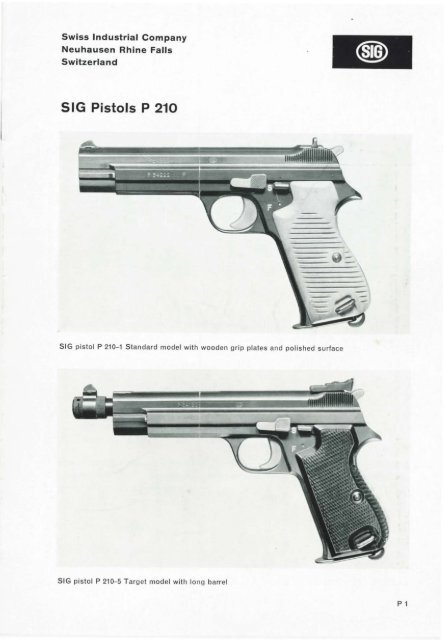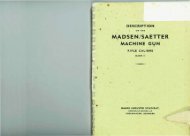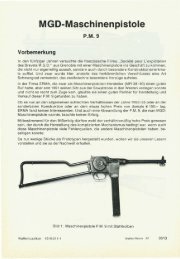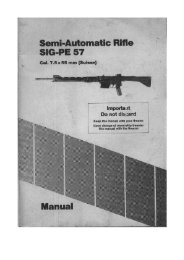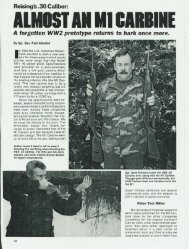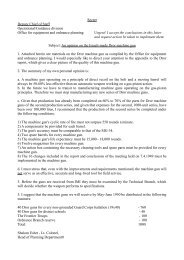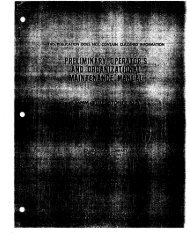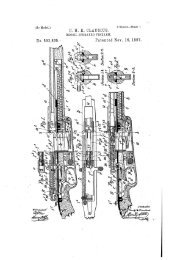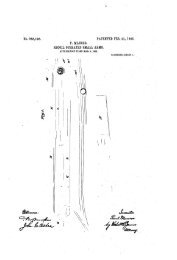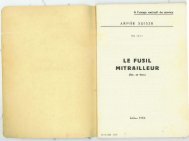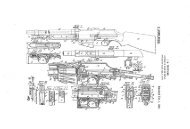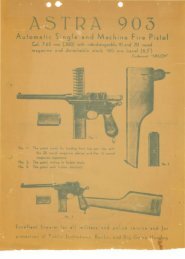SIG Pistols P210 Brochure.pdf - Forgotten Weapons
SIG Pistols P210 Brochure.pdf - Forgotten Weapons
SIG Pistols P210 Brochure.pdf - Forgotten Weapons
You also want an ePaper? Increase the reach of your titles
YUMPU automatically turns print PDFs into web optimized ePapers that Google loves.
Swiss Industrial Company<br />
Neuhausen Rhine Falls<br />
Switzerland<br />
<strong>SIG</strong> <strong>Pistols</strong> P 210<br />
<strong>SIG</strong> pistol P 210-1 Standard model with wooden grip plates and polished surface<br />
<strong>SIG</strong> pistol P 210-5 Target model with long barrel<br />
p 1
<strong>SIG</strong> pistol P 210-6 Target model with short barrel<br />
a) The mobile part is made up of the following components:<br />
P4<br />
barrel with locking and unlocking cam. The ribs on top of the barrel lock in the cor<br />
responding grooves inside the slide. On the target model with long barrel, the front<br />
sight and front sight base are installed on the fore en d of the barrel.<br />
slide provided with lateral guides. Th e fore part forms the bushing for the barrel and<br />
the recoil spring. The slide holds the front and rear sights which are both adjus<br />
table for windage. Th e target pistols are equipped with a special micrometer rear<br />
sight, which can be adjusted laterally as we ll as vertical ly. On the target model<br />
(P 210-5) with long barrel, the front sight is installed on the fore end of the barrel.<br />
The extractor, firing pin and firing pin spring are fitted behind the ejection port. The<br />
slide holds furthermore the locking grooves for the barrel.<br />
Dismantled <strong>SIG</strong> pistol P 210<br />
-<br />
b) the fixed part is made up of the following components:<br />
frame fitted with guides for the slide, with bushings for the slide stop, the magazine<br />
and the action. Th e frame also holds the trigger, the trigger rod, the thumb safety<br />
and the magazine safety. Th e grip plates are fastened to the frame. The target<br />
models have a grooved front grip strap, so that the pistol lies better in the hand.<br />
slide stop joins th e fix ed to the mobile part.<br />
action casing holding the complete action (hammer, sear, hammer spring, double<br />
pu ll lever, a. s. o.). Th e ejector is formed by the action casing. In the target model, the<br />
action casing is fixed in the frame by a screw.<br />
recoil spring with recoil spring rod and loop. The spring is pre-stressed on the rod.<br />
The complete recoil spring can easily be removed.<br />
c) magazine for 8 cartridges.<br />
P5
4. Operation<br />
Wh en th e pistol is loaded, the ribs on the barrel lock into th e corresponding grooves of<br />
th e slide, thus uniting the barrel and the slid e. Wh en a cartridge is fired, the recoil drives<br />
the slide rearwards. Until 3 mm {' /s") recoil way, th e barrel does not get out of its firing<br />
axis, while the bullet leaves the barrel after a 2 mm ('/,2") recoil. After 3 mm recoil, the<br />
barrel swings downwards, driven by the slide stop and the cam. The lock ing between<br />
barrel and slide is suppressed and the barrel is stopped by the frame. The slide continu es<br />
its rea rward motion. The recoil energy of the slide is used to ext ract and eject th e empty<br />
case, to cock the hammer and compress the recoil spring. The recoil way of the slide is<br />
limited by the frame. After th e recoil has been completed, th e slide is driven forward<br />
by th e recoil spring. It pushes a new cartridge into the chamber. At the end of the forward<br />
motion, barrel and slide are locked again.<br />
5. Safeties<br />
The following safety devices provide greatest security:<br />
a) Thumb safety. This lever locks the trigger rod and th e trigger. The hammer cannot<br />
be disengaged.<br />
b) Magazine safety. T he magazine safety lowers th e trigger rod when the magazine is<br />
re move d. Trigger rod and sear are separated, the hammer cannot be disengaged.<br />
c) Safety when the slide is not fully closed. If the slide is not fully closed , it lowers<br />
the trigger rod, thus preventing it from engagi ng with the sear. The hammer cannot<br />
be disengaged.<br />
d) Safety notch. A second notch retains the hammer if it is let loose by inadvertance<br />
p 6<br />
before it engages with th e sear by its principal notch.<br />
Parts having to be changed to fire either<br />
9 or 7.65 mm Parabellum cartridges<br />
Conversion unit .22 long rifle<br />
6. Changing the calibre<br />
Th e pistol can be equipped with a ba rrel for either 9 mm or 7,65 mm ca libre. Only the<br />
barrel and recoil sp ring have to be changed to fire one or the other cal ibre. The magazine<br />
remains the same in both cases.<br />
The weapon can furth ermore be used with a conversion unit .22 long rifle consisting of a<br />
lighter slid e, a barrel .22 with co rresponding recoil spring and a magazine. With the help<br />
of this conversion unit, the .22 long rifle ammunition can be fired automatically with<br />
excell ent accuracy. The function of the pistol remains the same as with the normal<br />
ammunition, the barrel however is unlocked, because of the reduced recoil. T his con<br />
version unit is most interesting for shooting training since the .22 ammunition is less<br />
expensive than the regular pistol ammuniti on.<br />
These conversion units can only be suppli ed w ith standard 120 mm (4'/.'') barrel and<br />
with ordinary rear sight.<br />
P7
Micrometer rear sight<br />
7. Sighting devices of the Target models<br />
a) Micrometer rear-sight<br />
click-adjustable for windage and elevation<br />
Width of the square rear-sight notch<br />
Depth of the sighting notch .<br />
3 mm ( 1 /s")<br />
1,5 mm (' jn")<br />
Possibilities of adjustment in pistols with standard (4 3 //') barrel, at 50 m<br />
total vertical (elevation) adjustment<br />
elevation adjustment per click ..<br />
total lateral (windage) adjustment<br />
windage adjustment per click<br />
Possibilities of adjustment in pistols with long (6") barrel, at 50 m<br />
total vertical (elevation) adjustment<br />
elevation adjustment per click ..<br />
total lateral (windage) adjustment<br />
windage adjustment per click ..<br />
b) Special front sight<br />
PS<br />
laterally adjustable, vertically interchangeable<br />
Width of sight .<br />
Height of sight<br />
720 mm (2' 4'//')<br />
48 mm (1 '/s'')<br />
492 mm (1 ' 7 3 /s")<br />
16,4 mm ('/3)<br />
637,5 mm (2' 1'/s'')<br />
42,5 mm (1 '/3)<br />
435 mm (1 ' 5'/s'')<br />
14,5 mm ('/s'')<br />
3 mm (' Is )<br />
7 mm ('//')<br />
<strong>SIG</strong> pistol P 210-2 (cut-away model}<br />
8. Particularities<br />
The particularities of the pistol can be summarized as follows :<br />
a) Accuracy. The cam prevents any motion of the barrel out of the firing axis as long as<br />
the bullet has not left the barrel.<br />
The weapon is fitted with a fine double pull trigger which can easily be adjusted.<br />
The center of gravity is located very favorably around the trigger. Therefore the<br />
pistol "climbs " less and aiming is facilitated, especially when firing rapidly.<br />
Th ese particularities assure a fine accuracy.<br />
b) Function. The mobile parts inside the receiver and the slide are protected against<br />
dust and dirt by the closed construction.<br />
The massive slide acts as working mass.<br />
Owing to these two characteristics, the pistol is very reliable.<br />
c) Safety. Th e pistol can be dismantled, assembled, loaded and unloaded with the<br />
safety lever on " S " (safe).<br />
pg


